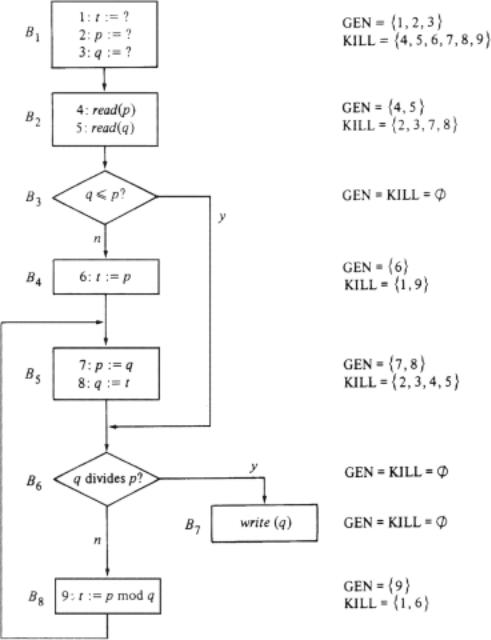
Data-Structures-And-Algorithms-Alfred-V-Aho
.pdfData Structures and Algorithms: CHAPTER 5: Advanced Set Representation Methods
|
In the tree implementation of MFSET: |
|
a. Show that Ω(n log n) time is needed for certain lists of n |
|
operations if path compression is used but larger trees are |
**5.21 |
permitted to be merged into smaller ones. |
b. Show that O(nα(n)) is the worst case running time for n operations if path compression is used, and the smaller tree is always merged into the larger.
5.22
Select a data structure and write a program to compute PLACES (defined in Section 5.6) in average time O(n) for strings of length n.
*5.23
Modify the LCS procedure of Fig. 5.29 to compute the LCS, not just its length.
*5.24 Write a detailed SPLIT procedure to work on 2-3 trees.
If elements of a set represented by a 2-3 tree consist only of a key field,
*5.25
an element whose key appears at an interior node need not appear at a leaf. Rewrite the dictionary operations to take advantage of this fact and avoid storing any element at two different nodes.
Bibliographic Notes
Tries were first proposed by Fredkin [1960]. Bayer and McCreight [1972] introduced B-trees, which, as we shall see in Chapter 11, are a generalization of 2-3 trees. The first uses of 2-3 trees were by J. E. Hopcroft in 1970 (unpublished) for insertion, deletion, concatenation, and splitting, and by Ullman [1974] for a code optimization problem.
The tree structure of Section 5.5, using path compression and merging smaller into larger, was first used by M. D. McIlroy and R. Morris to construct minimum-cost spanning trees. The performance of the tree implementation of MFSET's was analyzed by Fischer [1972] and by Hopcroft and Ullman [1973]. Exercise 5.21(b) is from Tarjan [1975].
The solution to the LCS problem of Section 5.6 is from Hunt and Szymanski [1977]. An efficient data structure for FIND, SPLIT, and the restricted MERGE (where all elements of one set are less than those of the other) is described in van Emde Boas, Kaas, and Zijlstra [1977].
http://www.ourstillwaters.org/stillwaters/csteaching/DataStructuresAndAlgorithms/mf1205.htm (45 of 47) [1.7.2001 19:09:33]
Data Structures and Algorithms: CHAPTER 5: Advanced Set Representation Methods
Exercise 5.6 is based on an efficient algorithm for matching patterns developed by Weiner [1973]. The 2-3 tree variant of Exercise 5.16 is discussed in detail in Wirth [1976]. The AVL tree structure in Exercise 5.18 is from Adel'son-Vel'skii and Landis [1962].
†Recall the left child of the root is a descendant of itself, so we have not ruled out the possibility that x is at the left child of the root.
†The highest-valued node among the descendants of the left child would do as well.
†Recall that all logarithms are to the base 2 unless otherwise noted.
†Trie was originally intended to be a homonym of "tree" but to distinguish these two terms many people prefer to pronounce trie as though it rhymes with "pie."
†VALUEOF is a function version of COMPUTE in Section 2.5.
†There is another version of 2-3 trees that places whole records at interior nodes, as a binary search tree does.
†All nodes, however, take the largest amount of space needed for any variant types, so Pascal is not really the best language of implementing 2-3 trees in practice.M
†A useful variant would take only a key value and delete any element with that key.
†We say a is congruent to b modulo n if a and b have the same remainders when divided by n, or put another way, a-b is a multiple of n.
†Note that n- 1 is the largest number of merges that can be performed before all elements are in one set.
‡ Note that our ability to call the resulting component by the name of either of its constituents is important here, although in the simpler implementation, the name of the first argument was always picked.
† Strictly speaking we should use a different name for the MERGE operation, as the implementation we propose will not work to compute the arbitrary union of disjoint sets, while keeping the elements sorted so operations like SPLIT and FIND can be performed.
http://www.ourstillwaters.org/stillwaters/csteaching/DataStructuresAndAlgorithms/mf1205.htm (46 of 47) [1.7.2001 19:09:33]
Data Structures and Algorithms: CHAPTER 5: Advanced Set Representation Methods
Table of Contents Go to Chapter 6
http://www.ourstillwaters.org/stillwaters/csteaching/DataStructuresAndAlgorithms/mf1205.htm (47 of 47) [1.7.2001 19:09:33]

http://www.ourstillwaters.org/stillwaters/csteaching/DataStructuresAndAlgorithms/images/fig4_1.gif
http://www.ourstillwaters.org/stillwaters/csteaching/DataStructuresAndAlgorithms/images/fig4_1.gif [1.7.2001 19:09:42]

http://www.ourstillwaters.org/stillwaters/csteaching/DataStructuresAndAlgorithms/images/fig4_3.gif
http://www.ourstillwaters.org/stillwaters/csteaching/DataStructuresAndAlgorithms/images/fig4_3.gif [1.7.2001 19:09:57]

http://www.ourstillwaters.org/stillwaters/csteaching/DataStructuresAndAlgorithms/images/fig4_7.gif
http://www.ourstillwaters.org/stillwaters/csteaching/DataStructuresAndAlgorithms/images/fig4_7.gif [1.7.2001 19:10:04]

http://www.ourstillwaters.org/stillwaters/csteaching/DataStructuresAndAlgorithms/images/fig4_10.gif
http://www.ourstillwaters.org/stillwaters/csteaching/DataStructuresAndAlgorithms/images/fig4_10.gif [1.7.2001 19:10:13]

http://www.ourstillwaters.org/stillwaters/csteaching/DataStructuresAndAlgorithms/images/fig4_13.gif
http://www.ourstillwaters.org/stillwaters/csteaching/DataStructuresAndAlgorithms/images/fig4_13.gif [1.7.2001 19:10:19]

http://www.ourstillwaters.org/stillwaters/csteaching/DataStructuresAndAlgorithms/images/fig4_15.gif
http://www.ourstillwaters.org/stillwaters/csteaching/DataStructuresAndAlgorithms/images/fig4_15.gif [1.7.2001 19:10:28]

http://www.ourstillwaters.org/stillwaters/csteaching/DataStructuresAndAlgorithms/images/fig4_16.gif
http://www.ourstillwaters.org/stillwaters/csteaching/DataStructuresAndAlgorithms/images/fig4_16.gif [1.7.2001 19:10:44]
